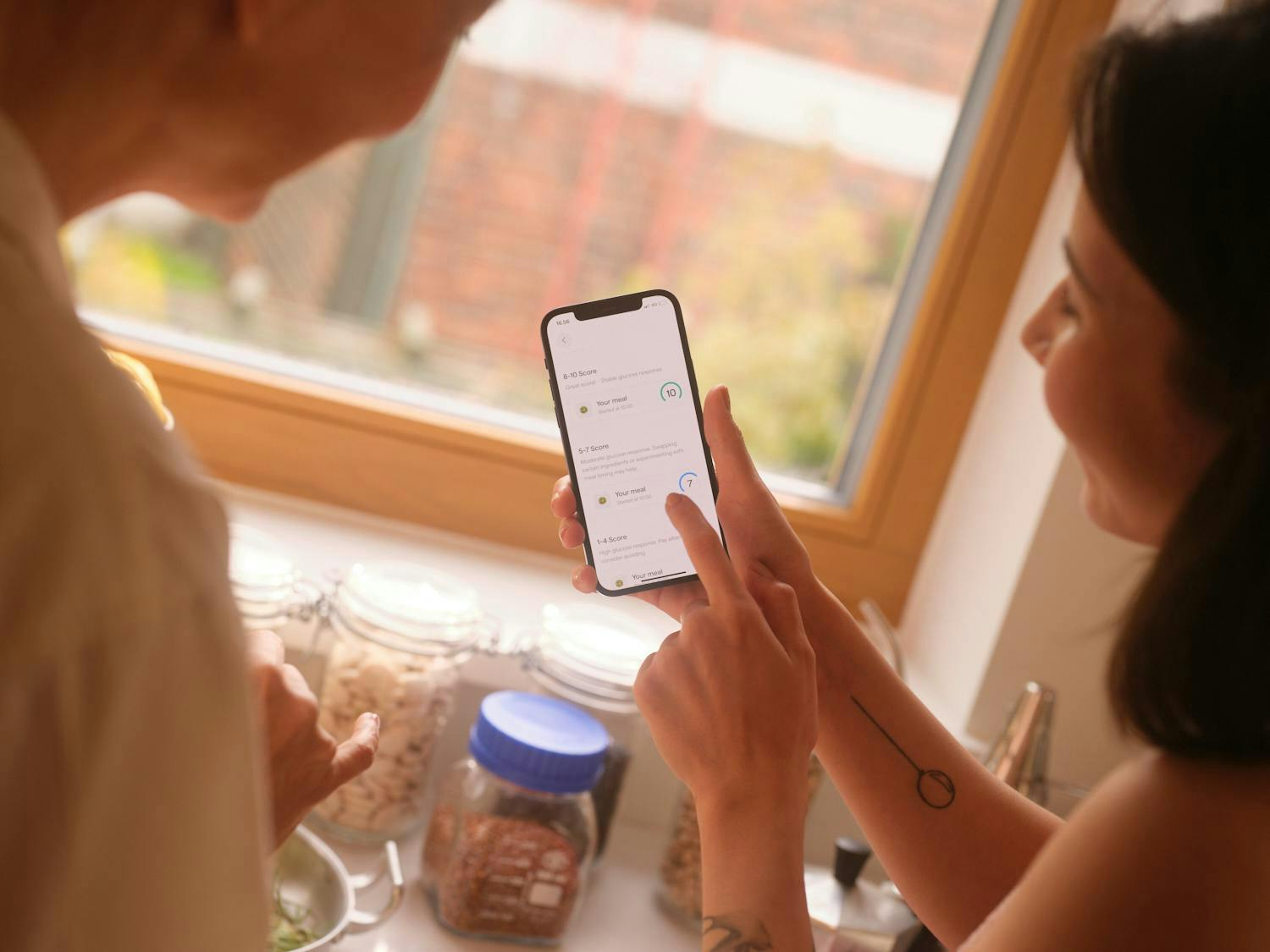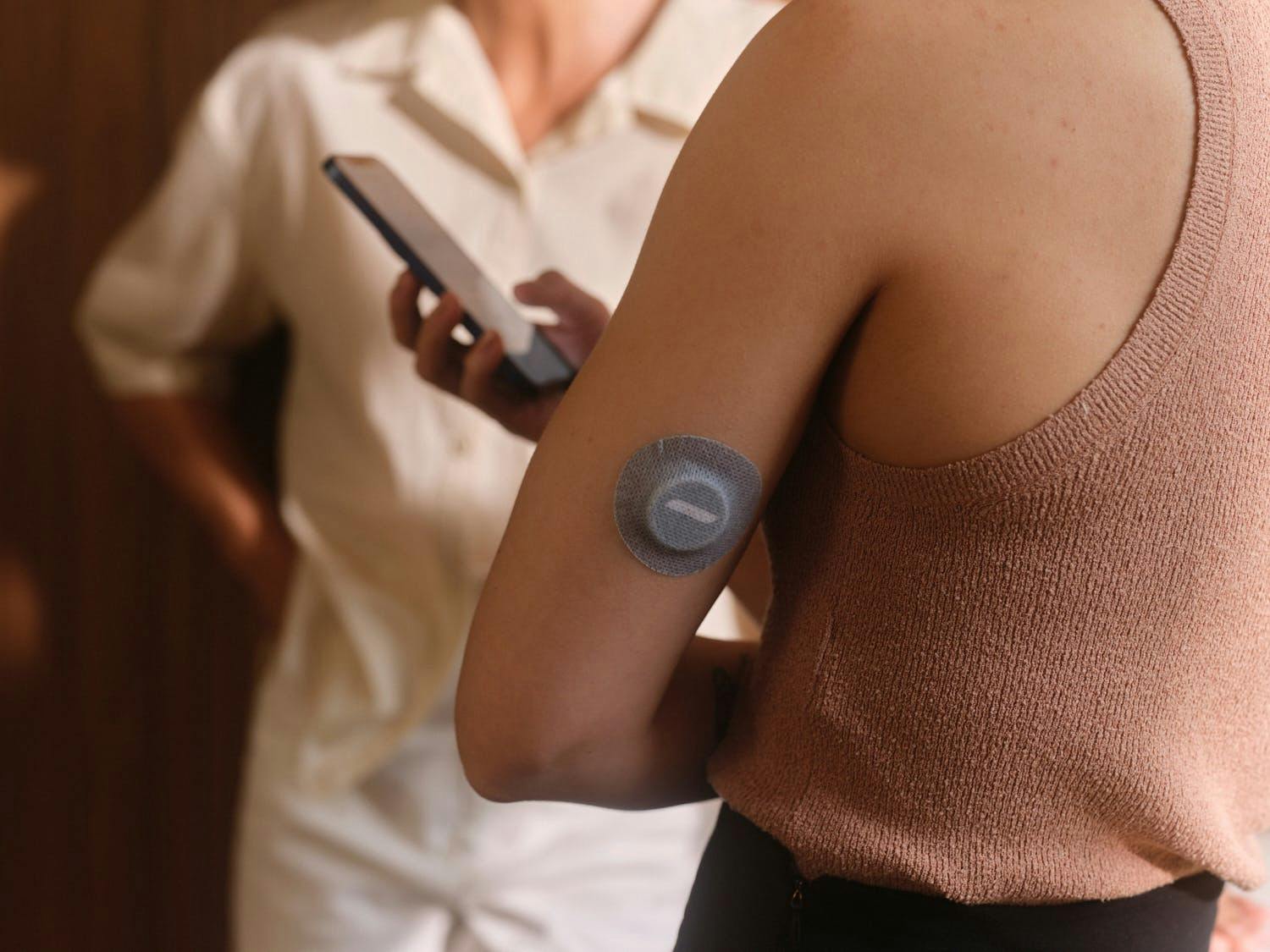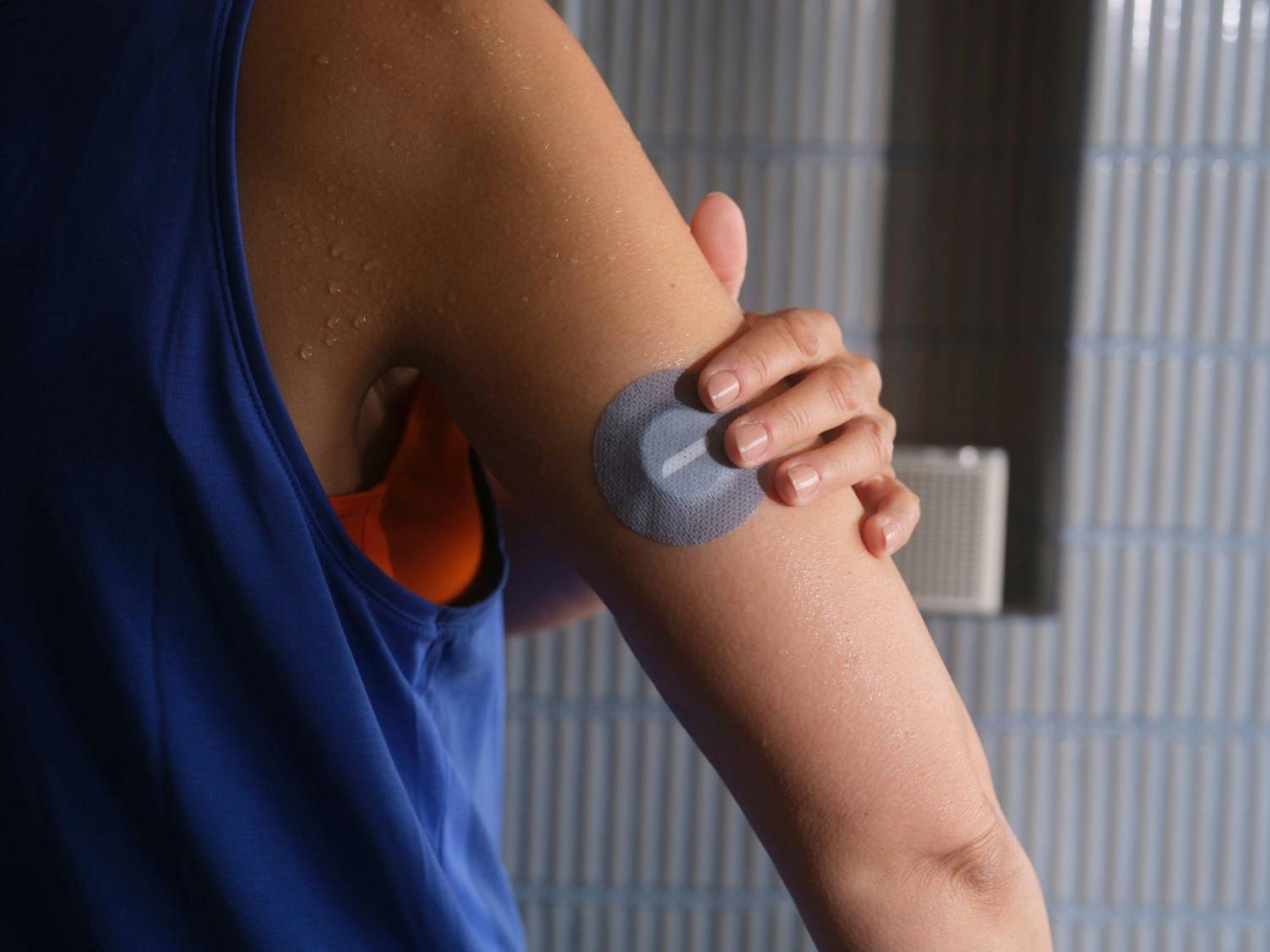Obesity has become a worldwide epidemic along with the increasing rates of insulin resistance and metabolic syndrome [1]. An alarming 12% of American adults are considered metabolically healthy [2]. Put another way, 88% of Americans are at risk for poor metabolic health conditions such as cardiovascular disease and insulin resistance.
A key tool for monitoring your blood glucose levels is using a continuous glucose monitor (CGM). A CGM is a small device that is placed on the back of your arm and measures your blood glucose levels in real-time, 24/7, for 14 consecutive days.
Recent research supports the use of a CGM for people without diabetes [3]. CGMs have emerged as a powerful tool for monitoring and improving healthspan and quality of life.
We’re debunking some of the CGM misconceptions, while also discussing how nutrition and lifestyle factors influence metabolic health as well as the benefits of using a CGM in with an app like Veri.
1. CGMs are only useful for people with diabetes or prediabetes
When people hear the words “blood sugar” or “glucose,” they often think it’s only applicable to those with a health condition like diabetes or pre-diabetes. However, balancing your blood glucose is a foundational component of your overall health as it impacts your hormones, gut health, metabolism, thyroid, mood, hunger cues, stress response, and more.
CGMs were originally intended for people with diabetes to track their glucose and know when levels got too high or too low so they could either inject more insulin or consume glucose to get back to baseline. Recently, CGM use in non-diabetics has grown as more people want to take control of their health before Type 2 diabetes develops [4].
Why does it matter?
Metabolic health is a spectrum, meaning that a lot happens between being in optimal health and developing Type 2 diabetes. To prevent a future chronic condition, you first need to understand where you lie on the metabolic health spectrum.
Another caveat is that metabolic dysfunction symptoms only tend to show up when it has become a severe issue — which is why you’re often unaware if your metabolic health is declining. Oftentimes you don’t realize that there are tools to help slow down or reverse your health trend before it gets out of control. Glucose variability matters as much as, if not more than, average glucose or fasting glucose, allowing you to understand where you are on the metabolic spectrum. Other measures such as A1C tests, glucometers, waist circumference, and lipids can’t show you your variability — the only way is by wearing a CGM.
So even if you aren’t overweight or prediabetic, there are many reasons to pay attention to your blood sugar. And you can’t manage what you don’t measure.
2. High glucose levels or spikes are always bad
When you eat foods, primarily carbohydrates, the food gets broken down to its smallest form glucose (or sugar). Glucose enters your bloodstream, increasing your glucose levels, and is used immediately as energy or is stored for later use. If you’re wearing a CGM, you’ll see a glucose excursion, also called a “spike.”
You may be surprised to hear that not all spikes in your blood glucose levels are food-related or threatening to your life. Your glucose levels may rise for various reasons:
- High-intensity workout: In response to a high-intensity or hard workout, your liver releases glucose into the bloodstream which causes a spike in your blood sugar. Your muscles then use this glucose for energy to help you in your workout and for recovery. This is a positive adaptation that allows us to efficiently use stored glucose.
- Stress: A short-term instance of stress also causes the liver to release glucose into the bloodstream, resulting in a short-term spike. While we don’t want to be in a state of chronic stress,, there are different types of stressors — some of which are health promoting. For instance, if you’re giving a big presentation, you might see a spike in glucose, but this increase in available energy from glucose and sharpened focus from cortisol can help you perform better in the moment. Balancing the different types of stress is key here.
- Dehydration: After an event that may result in dehydration, your blood loses some of the water that’s in it, leading to more concentrated levels of glucose in your blood, and therefore a higher reading of your blood sugar. In this situation, your body needs more water rather than less sugar.
- Illness/sickness: Surprisingly even if you just have a cold, your body will have higher glucose levels as a result of it fighting off an infection. This is another stressor where the higher glucose levels are a positive adaptation to help your body power its defense system.
- An infusion or IV high in vitamin C: If you're wearing a CGM and get an IV containing vitamin C, you'll see an erroneous spike due to electrochemical interference [5]. However, moderate vitamin C supplementation, like with a multivitamin, has been shown in some cases to actually help glycemic control [6]. That said, we always recommend you use natural sources to get vitamin C like broccoli or citrus.
Why does it matter?
The goal isn’t to have flat glucose levels as your body needs glucose for fuel to perform daily activities. Flat levels would mean no glucose consumption, but carbohydrates are a primary macronutrient that fuel our bodies. A gradual rise in glucose followed by a gradual decline to baseline is a normal physiological response. You're aiming for blood glucose levels that represent rolling hills rather than jagged mountains. The latter can result in fatigue, shakiness, sugar cravings, weight gain, and more. And without managing your blood sugar, you’re at an increased risk of a chronic condition. Collecting continuous data with a CGM allows you to make choices that are right for you and your unique body.
3. CGMs alone can provide you with actionable insights about your lifestyle
Tracking your glucose levels is the first step to managing your metabolic health. But a measurement alone won’t provide you with the guidance needed to take action.
This is where pairing a CGM with an app like Veri comes in. This combination gives you the ability to transform measures into habits. The Veri app contextualizes the CGM data and provides insights to help you form health-promoting habits.
Why does it matter?
Pairing a CGM with the Veri app allows you to take your individual data and make lifestyle decisions that will help propel you towards your unique goals. When you start tapping into this space and learning how your unique body responds to external factors, you will uncover discoveries such as (but not limited to):
- How your metabolism and glucose levels respond to your lifestyle
- Hacks to avoid blood sugar spikes throughout the day
- The preferred meal time for your specific health goals
- The best foods for you and your body
- Which habits make you feel your best
- Where you land on the metabolic health spectrum
Along with the short-term benefits of stabilizing your blood sugar (i.e., stable energy, increased focus, improved moods, fewer cravings, better skin, etc.), there’s a link between your blood glucose and every one of your organ systems. And so, with the help of the Veri app, you will be improving your health as a whole.
4. CGMs only offer information related to your diet and eating habits
Similar to the misconception that blood sugar spikes result only from food, many believe that CGMs only provide information that’s diet related. Although you are able to track your food and see exactly how that meal impacted your blood sugar, CGMs offer more than diet and eating habits alone.
Why does it matter?
Research has shown that the Four Pillars are the most impactful areas for improving behaviors that are linked to stable glucose levels, improved insulin sensitivity, and overall metabolic function.
- Nutrition: A diet high in processed foods and refined carbohydrates results in you riding the blood glucose rollercoaster daily, which leads to poor metabolic health. Both what you eat and when you eat can affect your glucose response. Pairing carbohydrate-rich foods with a protein and/or fat can help curb your glucose response.
- Exercise: A lack of exercise and movement has been shown to be a precursor for metabolic syndrome. Incorporating resistance training into your weekly workout schedule is critical for overall metabolic health. Also, going for just a 10 minute post-meal walk can lower your glucose response.
- Sleep: Lack of sleep, and even inconsistent sleep, has been shown to decrease insulin sensitivity. By understanding the impact of food on sleep and sleep on metabolic health, you can improve your glucose response throughout the night and the following day.
- Stress: High stress levels (i.e., high cortisol) keep your body in a constant fight-or-flight state, which increases your blood glucose levels. Tapping into stress reduction techniques will help lower your cortisol levels and therefore lower your blood glucose response to foods and external factors.
Each of these four areas plays a strong role in your metabolic and overall health. Utilizing a CGM with the Veri app allows you to take a look inside each and focus on the areas that may need more attention. The pillar that you need to focus on may be different from the next person — and that’s the beauty of personalized data.
5. You can’t lose weight with a CGM
Adult weight gain and obesity are common risk factors for insulin resistance and other metabolic health conditions, and 4 in 10 American adults without diabetes are insulin resistant [7, 8].
Insulin resistance occurs when your cells stop responding to insulin (a hormone), which causes too much blood sugar to circulate in the bloodstream. This leads to a vicious cycle where insulin resistance contributes to weight gain, further reducing insulin sensitivity. Insulin sensitivity refers to how efficient insulin is at bringing the glucose from your bloodstream into your cells to be used as energy.
To lose weight that was brought on due to insulin resistance, you first need to address the insulin resistance. This is where a CGM is critical. The first goal is to stabilize your glucose levels and improve your insulin sensitivity.
A CGM provides you with personalized information that will help you make informed nutrition and lifestyle choices towards your goals whether that’s losing weight, sleeping better, gaining muscle mass, etc.
You can lose weight with calorie restriction alone, but it’s often more difficult and leads to rebounding or hitting the weight loss plateau. Monitoring your glucose levels with a CGM helps you understand how to fix the underlying metabolic health issues that were causing the weight gain in the first place. You need to fix the engine first, then you’ll be able to manage your weight more effectively.
Why does it matter?
Whether you’re just starting your health journey or you’ve hit the weight loss plateau, using a CGM can help you learn more about how your body responds to foods you eat and meal timing, sleep quality, stress level, and different types and frequencies of exercise.
Once you are able to understand the impact of specific external factors on your glucose levels, you can make adjustments to your diet and lifestyle to get the needle moving again towards your goals.
6. CGMs are less accurate than glucometers and other glucose-tracking tools
There are several ways to monitor blood glucose: hemoglobin A1C test, glucose tolerance test, glucometer, and a CGM — but not all of these offer the same insights.
A CGM measures the glucose that is in the interstitial fluid (i.e., fluid between the cells) whereas a glucometer or finger prick measures the glucose in the blood.
Research has shown that interstitial glucose differs from blood glucose both in magnitude and in timing [9]. These differences may be due to variations in glucose uptake by the cells, how the glucose is used, how it’s eliminated in the blood, the interstitial space, and the cells.
To put it another way, picture a rollercoaster where the seat in the front of the cart is the blood glucose reading from a glucometer and the seat in the back of the cart is the reading from your CGM [10]. When you’re going up the track, the front of the cart (or your blood glucose value) is higher than the back of the cart (or your interstitial glucose). But as you start to descend the hill, the opposite is true (i.e., blood glucose is now lower than the interstitial fluid).
This pattern is characterized by a 15-minute time delay — the time period in which blood glucose is leaving the bloodstream and entering the interstitial fluid. When glucose levels are changing rapidly due to eating, exercising, a stressful event, you will likely see an even larger difference between readings.
According to the FDA, glucometers are 95%-99% accurate when taking your blood sugar measure [11]. Although finger pricks and tests alike give the most accurate results of your glucose testing, they are all a snapshot in time that don’t tell the whole story.
A CGM identifies the missing piece: glucose variability.
Glucose variability is the measure of how much your glucose varies within a 24-hour period. Your glucose is going to increase and decrease throughout the day, which is normal. But you want to prevent large spikes and dips in your levels — remember, you don’t want to be on the glucose rollercoaster.
Research has shown that variability in your glucose levels is even more meaningful than average glucose or A1C for both diabetics and non-diabetics [12]. High variability is associated with the development of many chronic diseases and conditions because it increases insulin resistance and affects the elasticity of blood vessels [12, 13].
Why does it matter?
Being able to gather data 24/7 is crucial to gathering all the pieces of the puzzle to start making data-informed decisions towards your health goals.
Key takeaways
CGM use is on the rise as more people want to take control of their health before it gets to a point of a diagnosis. We debunked the common misconceptions about wearing a CGM and highlighted the benefits of how a CGM is a key tool on your metabolic health journey.
- Metabolic health is a spectrum and you can’t manage what you don’t measure. Research has shown that CGMs are key tools in preventing future chronic diseases for non-diabetics.
- Not all blood sugar spikes are food-related or health threatening and a flat line is not the goal Your blood glucose levels can spike as a result from a high-intensity exercise, a stressful event, dehydration, an illness/sickness, or an infusion of Vitamin C. These spikes are normal and should not be a reason for concern.
- Pairing a CGM with an app like Veri gives you the opportunity to turn measures into habits. Using a CGM alone will not give you the insights and guidance you need to make lasting changes.
- Along with nutrition information, CGMs and the Veri app give you information on your glucose response to exercise, sleep, and stress. These are the four pillars of metabolic health and all play a crucial role in your health outcomes.
- A CGM isn’t a cure-all tool for weight loss, but it will provide data-informed, personalized guidance to what is and what isn’t working for your body and will allow you to make adjustments as you see fit.
- There are several ways to measure your blood sugar levels, but not all of them offer the same insights. Using a CGM shows trends over time rather than a snapshot in time. Glucose variability is a key measure in your glucose response to the many external factors that you experience in a day.
References:
- https://www.ahajournals.org/doi/10.1161/CIRCRESAHA.119.315896
- https://www.liebertpub.com/doi/10.1089/met.2018.0105
- https://www.diabetesresearchclinicalpractice.com/article/S0168-8227(18)30091-3/fulltext
- https://pubmed.ncbi.nlm.nih.gov/35856435/
- https://www.google.com/url?q=https://jidc.org/index.php/journal/article/view/33690202&sa=D&source=docs&ust=1691072027097208&usg=AOvVaw08FSWfeZsh1HQg8aJhb01u
- https://diabetesjournals.org/care/article/44/2/618/35482/Effects-of-Vitamin-C-Supplementation-on-Glycemic
- https://www.ncbi.nlm.nih.gov/pmc/articles/PMC6832997/#:~:text=Adult%20weight%20gain%20and%20obesity,7%2C8%2C9%5D.
- https://academic.oup.com/jcem/article/107/1/e25/6362635?guestAccessKey=5b7c3daf-2030-47db-92ef-6e6388e691ba&login=false
- https://diabetesjournals.org/care/article/26/8/2405/22733/Physiological-Differences-Between-Interstitial
- https://www.medtronicdiabetes.com/customer-support/sensors-and-transmitters-support/why-sensor-glucose-does-not-equal-blood-glucose
- https://www.webmd.com/diabetes/blood-sugar-meters-cgms
- https://pubmed.ncbi.nlm.nih.gov/18299315/
- https://www.mdpi.com/1422-0067/12/5/3117


